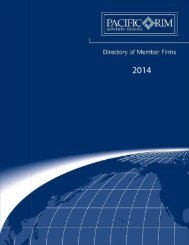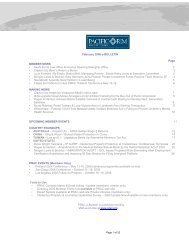A Guide to the Law of Securitisation in Australia - Clayton Utz
A Guide to the Law of Securitisation in Australia - Clayton Utz
A Guide to the Law of Securitisation in Australia - Clayton Utz
- No tags were found...
You also want an ePaper? Increase the reach of your titles
YUMPU automatically turns print PDFs into web optimized ePapers that Google loves.
10 Issues relat<strong>in</strong>g <strong>to</strong> debt securitiesissued by trustees5810.1 IntroductionAs <strong>in</strong>dicated <strong>in</strong> Section 1, many securitisations <strong>in</strong> <strong>Australia</strong>proceed by way <strong>of</strong> <strong>the</strong> relevant assets be<strong>in</strong>g held <strong>in</strong> a trust with<strong>the</strong> trustee issu<strong>in</strong>g debt securities. The use <strong>of</strong> trusts <strong>in</strong> this roleraises a number <strong>of</strong> legal issues. These <strong>in</strong>clude <strong>the</strong> follow<strong>in</strong>gwhich are reviewed <strong>in</strong> this section:• <strong>the</strong> role and function <strong>of</strong> security trust deeds <strong>in</strong> <strong>the</strong>secircumstances;• <strong>the</strong> nature <strong>of</strong> <strong>the</strong> trustee’s liability on its debt securities;• <strong>the</strong> trustee’s right <strong>of</strong> <strong>in</strong>demnification;• whe<strong>the</strong>r trustees can issue promissory notes; and• <strong>the</strong> effect at law if <strong>the</strong> trustee purchases debt securitiesissued by it <strong>in</strong> a different capacity.10.2 Security trust deeds <strong>to</strong> secure trustee debt securities10.2.1 BackgroundIf a trustee issues equity securities, <strong>the</strong> obligations under <strong>the</strong>secannot be secured by a charge over <strong>the</strong> trust’s assets <strong>in</strong> favour <strong>of</strong>a security trustee. The reason for this is that equity, by its nature,cannot be <strong>the</strong> subject <strong>of</strong> a security. However, when a trusteeissues debt securities, <strong>the</strong> rat<strong>in</strong>g agency requires this.Given that debt always ranks <strong>in</strong> priority <strong>to</strong> equity on a w<strong>in</strong>d<strong>in</strong>gup,this raises <strong>the</strong> issue <strong>of</strong> <strong>the</strong> relevance <strong>of</strong> security trust deedsfor trustee debt securities. If <strong>the</strong>y are not required for equity, whyare <strong>the</strong>y necessary for higher rank<strong>in</strong>g debt securities?The response <strong>of</strong> <strong>the</strong> rat<strong>in</strong>g agency <strong>to</strong> this question has beentw<strong>of</strong>old. The first response is that this is consistent with <strong>the</strong>irusual (though not uniform) requirements for debt securitiesissued by corporations. This though does not really answer <strong>the</strong>question. The second response is that a security trust deed isnecessary <strong>to</strong> overcome perceived shortcom<strong>in</strong>gs with <strong>the</strong> trustee’sright <strong>of</strong> <strong>in</strong>demnification from trust assets <strong>to</strong> meet liabilities on<strong>the</strong> debt securities. This second explanation is much more cogentand <strong>the</strong> legal basis for it is expla<strong>in</strong>ed <strong>in</strong> <strong>the</strong> next section. (There isalso a third response, which comes from lawyers, that securitytrust deeds are necessary for <strong>the</strong> enforceability <strong>of</strong> trustee debtsecurities: see section 1.3.3.)10.2.2 The nature <strong>of</strong> <strong>the</strong> trustee’s liability under its debtsecuritiesIt is a fundamental legal pr<strong>in</strong>ciple that obligations, such as owedunder a debt security, can only be <strong>in</strong>curred by an entityrecognised by <strong>the</strong> law as hav<strong>in</strong>g legal existence. Such entities<strong>in</strong>clude <strong>in</strong>dividuals, corporations or a comb<strong>in</strong>ation <strong>of</strong> <strong>the</strong>forego<strong>in</strong>g <strong>in</strong> partnership. A trust, on <strong>the</strong> o<strong>the</strong>r hand, is not aseparate legal entity. Ra<strong>the</strong>r, <strong>the</strong> term “trust” describes <strong>the</strong> basisupon which a person holds property.When a trustee issues a debt security, it is not <strong>the</strong> trust itselfthat is liable <strong>to</strong> meet <strong>the</strong> obligations under this. Instead, it is <strong>the</strong>trustee that is liable for <strong>the</strong> debt security as if it had issued itpersonally.The result is that when a trustee <strong>of</strong> a securitisation trust issues adebt security, at law <strong>the</strong> trustee is personally liable on <strong>the</strong>security. It is <strong>the</strong> party <strong>to</strong> whom an <strong>in</strong>ves<strong>to</strong>r has recourse and maysue if <strong>the</strong>re is a default (subject <strong>to</strong> any limitations on liabilityapply<strong>in</strong>g <strong>to</strong> that debt security, which is considered <strong>in</strong> section10.3).A trustee, however, is not expected <strong>to</strong> bear <strong>the</strong> liabilities <strong>of</strong> itstrust without compensation. It has a right <strong>of</strong> recoupment aga<strong>in</strong>st<strong>the</strong> trust assets for properly <strong>in</strong>curred trust liabilities.This right <strong>of</strong> recoupment spr<strong>in</strong>gs from three sources: <strong>the</strong> generallaw, statute (<strong>the</strong> Trustee Acts) and usually <strong>the</strong> relevant trustdeed.10.2.3 Shortcom<strong>in</strong>gs with <strong>the</strong> trustee’s right <strong>of</strong><strong>in</strong>demnificationThe right <strong>of</strong> a trustee for <strong>in</strong>demnification from <strong>the</strong> trust assets issubject <strong>to</strong> an important limitation. The actual quantum <strong>of</strong> <strong>the</strong>right is not calculated simply on <strong>the</strong> amount <strong>of</strong> <strong>the</strong> properly<strong>in</strong>curred trust debts. Instead, it is determ<strong>in</strong>ed after tak<strong>in</strong>g <strong>in</strong><strong>to</strong>consideration all <strong>of</strong> <strong>the</strong> trustee’s liabilities <strong>to</strong> <strong>the</strong> trust for o<strong>the</strong>rmatters. Thus, if <strong>the</strong> trustee commits a breach <strong>of</strong> trust so that itis personally liable <strong>to</strong> recoup <strong>the</strong> trust for this, <strong>the</strong> <strong>in</strong>demnity <strong>in</strong>respect <strong>of</strong> <strong>the</strong> properly <strong>in</strong>curred trust debts is accord<strong>in</strong>glyreduced. In o<strong>the</strong>r words, a runn<strong>in</strong>g account exists between whatis due by way <strong>of</strong> compensation <strong>to</strong> <strong>the</strong> trust for breaches <strong>of</strong> trustby <strong>the</strong> trustee and what is due <strong>to</strong> <strong>the</strong> trustee by way <strong>of</strong> its<strong>in</strong>demnity for properly <strong>in</strong>curred trust debts. Only if that balance is<strong>in</strong> favour <strong>of</strong> <strong>the</strong> trustee can it recover from <strong>the</strong> trust and <strong>the</strong>nonly <strong>to</strong> <strong>the</strong> extent <strong>of</strong> that balance.This has led <strong>to</strong> a concern, articulated particularly by <strong>the</strong> rat<strong>in</strong>gagency, that if <strong>the</strong> trustee properly issues unsecured debtsecurities (with its liability limited <strong>the</strong>reunder <strong>to</strong> <strong>the</strong> trustassets), but subsequently engages <strong>in</strong> an unrelated breach <strong>of</strong>trust, <strong>the</strong> trustee may not be entitled <strong>to</strong> recourse <strong>to</strong> <strong>the</strong> trustassets <strong>to</strong> meet <strong>the</strong> amount payable on <strong>the</strong> debt securities.This <strong>the</strong>n could lead holders <strong>of</strong> <strong>the</strong> debt securities <strong>to</strong> <strong>in</strong>cur a loss,even though <strong>the</strong>re are trust assets available <strong>to</strong> meet <strong>the</strong> amountdue on <strong>the</strong>ir debt securities.






